If Google is showing you this page directly, click here: https://www.headfonia.com/earmen-colibri-review/
Usability
Using the EarMen Colibri is easy and it’s pretty much “Plug ‘n play”. You just need to connect your cable to your source and that’s it. With the Colibri, no drivers are needed for Windows. Just make sure the Colibri is fully charged or hook it up to a power source during playback (you won’t hear a difference).
A nice feature is that the buttons on the side will provide you the full control of the (source) device and music, without you having to use your source. The volume control doesn’t work with my OnePlus 8 pro phone running Tidal, but it does work running Tidal via the HiBy Music app. I have tried the Colibri with my DELL laptop, OnePlus phone and even the SP2000T DAP, and it works as described.
It’s perhaps interesting to memorize the LED colours during usage. White means the unit is connected, green means you’re playing PCM, DSD or DXD, magenta stands for MQA as usual and red means the unit isn’t connected. When Bass Boost is engaged, the LED will shine brighter.
One important thing to pay attention to when using the Colibri, is the volume setting. With normal IEMs, the Colibri gets loud very fast. I hardly ever get past volume level 4, so pay attention that your volume level is all the way down when clicking play.
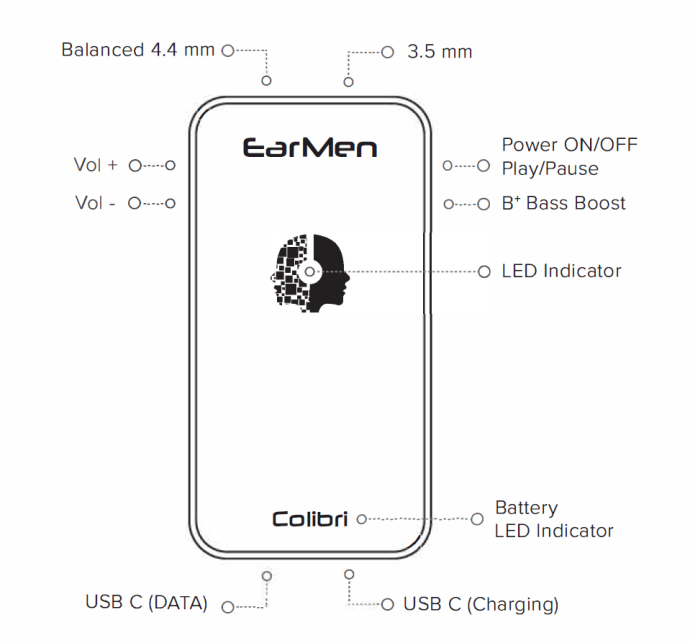
Sound – Intro
The EarMen design team describes Colibri’s sound as follows:
The most important feature of the device is its ability to provide clear and full-spectrum audio experience. Colibri uses the latest state-of-art hardware and software solutions in its construction, all of which come together to provide a natural and detailed listening experience.
The mid and high range frequencies beautifully complement the lowest tones, with consistent balance across all spectrums, resulting in a comprehensive sound image without the impression of any “missing” aspects of the music. The tones are displayed directly and without beautification, so whatever device you choose to use will be reflected accurately as intended by the designer.
EarMen Colibri shines through with excellent separation and pronounced stereo effect, while keeping all frequencies balanced during complex listening sessions
Let’s find out if that makes any sense!
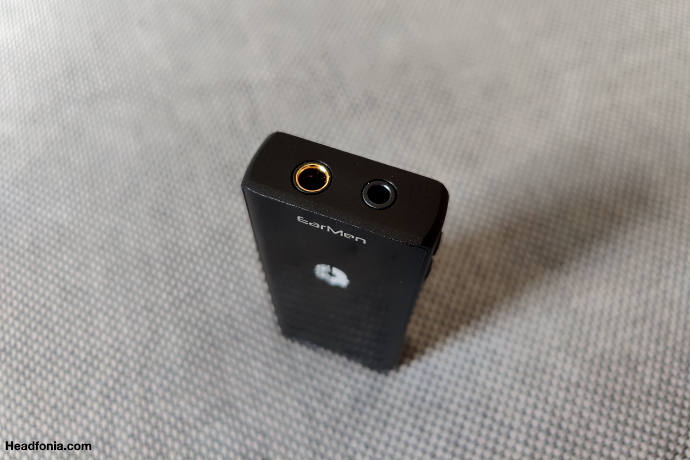
Sound – General
The Colibri was used with multiple sources, but most of the time with my laptop with ROON software, streaming Tidal and local files. A multitude of different ear and headphones were used, but always in balanced mode.
The most impressive characteristic of the Colibri to me is its excellent stereo image and balance. The imaging is really a pleasure to listen to.
EarMen’s Colibri is balanced in tuning and linear at all times (without bass boost). The tuning is somewhere in between neutral and warm but leaning more to the neutral side. This results is a good technical level, without going to the overanalytical side, and that combined with and an engaging and musical presentation. The Colibri is technically accurate, yet musical, just like its little brother, the EarMen Sparrow.
The Colibri from Bass to treble shows a good amount of body and presence. Your music will sound and feel full but not thick or unnatural. Bass is tight and controlled, the mids are rich and liquid and the treble section energetic yet easy on the ear.
Sound-stage wise, the Colibri scores on par with its competitors. The stage is good in both width and depth, but the width is more impressive. The depth and layering of bass and mids is good, but it’s not as impressive as with higher end DAC/AMPs. Overall the Colibri is spacious and naturally airy, with excellent separation.
Colibri’s pace is excellent, and its energy level is spot on, making it a pleasure to listen to, no matter the ear- or headphone used. Another strong point is the vocal presence. It has such a nice energy and it’s presented in an energetic and perhaps slightly more forward way, but it really works for me.
Points for improvement compared to higher end units, are the note decay and note extension. That being said, you will never feel it’s lacking with the Colibri unless you’re used to listening to a high-end desktop unit at home.
All-in-all the Colibri impressed me more than I expected. I wasn’t too sure what to expect from the battery implementation, but you get a super clean and clear sound in return for the bigger size. I have absolutely loved using it, and to be honest, it’s been the only dongle I have been taking with me on the go, next to the Chord Mojo 2.
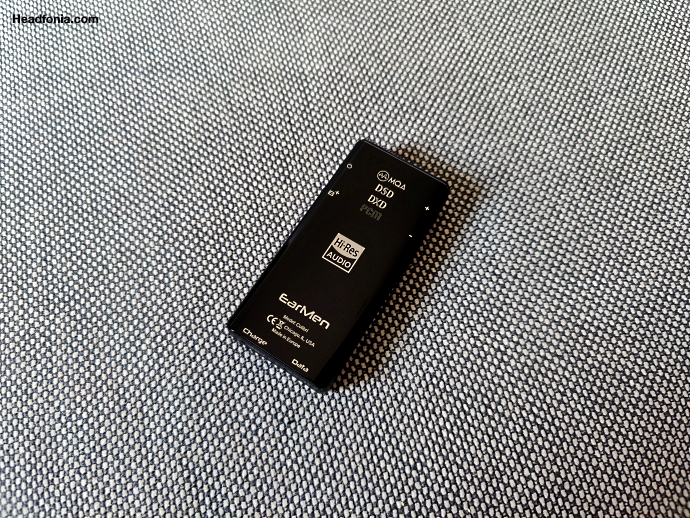
Sound – Classics
Colibri’s bass without the Boost tuned on, is fast and tight. The unit at all times is in control and you won’t ever feel the bass is loose or running into the mids. Bass comes in with a good punch and kick but bass never feels overly present or powerful. As said, Colibri’s presentation is balanced and that’s noticeable in the mids. The bass depth and layering are good, but as said it compared to higher units can be further improved in regard to layering and sub-bass presence.
The mids in the Colibri are very rich and super musical. The presentation is airy and natural, so without ever becoming too spacious. The rhythm is realistic, and the delivery is energetic and fast. The separation here is impressive, as well as the vocally strong presentation (energetic and slightly to the front). The points of improvement are in the layering, decay and note extension as previously mentioned.
Colibri’s treble section is energetic and musical but never sharp or too present. Its tonality perfectly matches that of the bass and mids and it makes it lively and exciting while never losing its naturality. I wouldn’t say the treble section is soft on the ear as it has a bit much energy for that. I quite like this typical tuning, as it’s very exciting, musical and engaging at the same time. Treble never is harsh or sharp, so there are no worries there.
Sound – SE vs Balanced
In single ended mode you lose a bit of the spaciousness, energetic presence and airiness. You get a less wide and deep sound stage with a more intimate and in your head presentation. The balanced output to my ears is more musical and liquid/lush, while the SE output is flatter and dryer. I absolutely suggest using the Colibri in balanced mode, as the technical level as well as the musicality, just is higher. The balanced output in all ways is more a pleasure to the ear.
As this depends on preference and taste, this for you can be totally different.
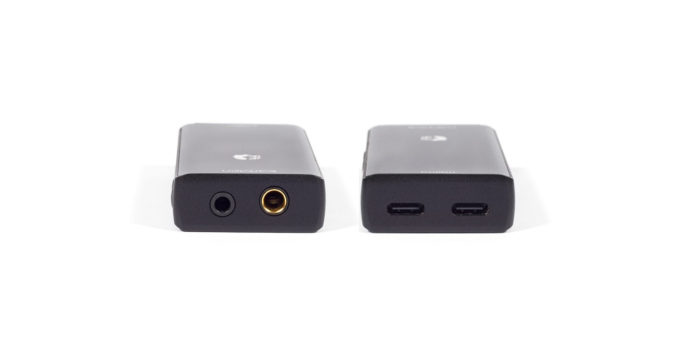
Sound – Bass Boost (also in balanced mode)
The bass boost impacts the lowest regions, giving them more amplitude and impact. At the same time, you lose a bit of tightness and speed. The bass boost to my ears reduces the precision and technical level, but it does give you “more bass”.
I have only used the bass boost on rare occasion where I was using a fully neutral and flat IEM with a bad recording. In general, I am not a fan of these kind of enhancements, but I know that many of you appreciate it, especially when on the go or in a louder environment.
Anyway, you have the option. You don’t have to use it, but you can.
Driveability
As mentioned earlier, the Colibri (at least for me) becomes loud quickly when using IEMs. It’s a quite powerful dongle in reality and it can easily drive many full-sized headphones in balanced mode. Headphones such as the Hifiman Arya Stealth, Meze Liric, Amiron Home and the Sennheiser HD 660 S can be driven without any issue whatsoever. And it’s not only about power and volume, but they also actually sound seriously good as well (as they should).
Don’t expect the Colibri to make your Susvara, HD 800 or Kennerton Thror to sound their very best, but any normal to drive headphone works perfectly fine with the Colibri.

Comparisons
The comparison part was done with my laptop, running Roon and the different dongles, in combination with the Hifiman Arya Stealth (and always in balanced mode where possible). The units chosen for this comparison are the DragonFly Cobalt from AudioQuest, the Luxury & Precision W2, the EarMen Sparrow and the Cayin RU6.
The L&P W2 ($299 USD) is more energetic, in your face (especially the vocals and upper mids) and a little lighter sounding, and it shows a better level of decay and improved note extension. The Colibri sounds more relaxed and fuller overall, with tighter bass. The soundstage is wider with more spacious and airier mids. For me the positioning and 3D imaging of the Colibri is at a higher level. Both units have great things going for them, but the Colibri is the one that’s more natural sounding, and easier to listen to, especially for longer listening sessions.
The Little Sparrow doesn’t sound as clean as the Colibri, and especially the spaciousness, airiness and sound stage are not as excellent. Sparrow compared to Colibri has a narrower presentation. Another big difference is how the Colibri sounds more exciting and more energetic. The Sparrow is flatter not as engaging. Detail and precision wise both units are at the same level, they share the same DAC chip after all. In short: they are both good units, but the Colibri clearly is the better one of both. It’s also quite a bit more expensive: €333 vs €199.
The AudioQuest DragonFly Cobalt ($329) is still one of the very best sounding single ended dongles. The sound it puts out in SE mode is impressive compared to that of the balanced dongles. In this case the Cobalt is lighter in presence and that goes from top to bottom. What the Cobalt has going for it are the better decay and note extension, and those are 2 of the points mentions as possible Colibri improvements. The treble and top end section of the Cobalt is also more extended, but it isn’t as easy on the ears as the Colibri is. Cobalt is technically super strong in SE mode, and in that regard it’s still one the better dongles out there. The Colibri is cleaner, fuller, more musical and more dynamic sounding, especially in balanced mode.
The Cayin RU6 R2R DAC(/AMP) is selling for $249 but it compares very well to the Colibri. Both have excellent technicalities, and their presentation and delivery are similar. The Colibri is tighter in the bass and softer in the delivery, but wider in sound stage. The RU6 has the better speed, note extension as well as decay. It also has that typical extremely clean/detailed R2R sound. These are both great units. The Colibri has a more natural feel to it, where the RU6 is more energetic and slightly more aggressive in its presentation. The full RU6 review will be published soon!

Conclusion
I have really enjoyed using the EarMen Colibri. I was a bit afraid of its size but in reality, it’s still small and it doesn’t bother you at all when on the go.
Sound-wise the Colibri with the ESS DAC chip performs well with a full presence and a natural and musical delivery. Not only does the Colibri sound good, but you also have a battery inside. This means you get a super clear sound, and it also doesn’t draw power from your source’s battery. On top of that you can control the volume via the device and engage a bass boost when needed.
Good sound, double outputs, volume control, bass boost and MQA. The EarMen Colibri has it all and as a result it receives our Recommended Buy award. It is now featured on the list of Best Buys here!

Page 1: EarMen, Colibri Features, Specifications, Box & Accessories, Design & Build quality & Lay-out





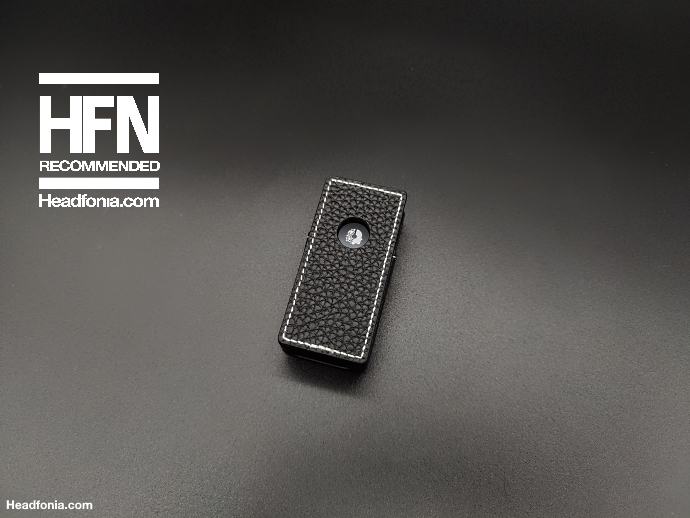
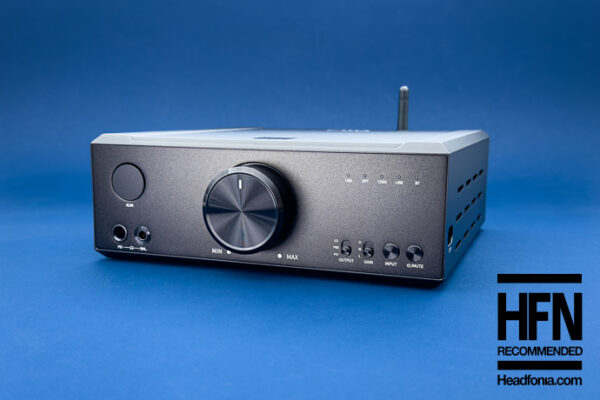

Sound Lover
It feel like a DAP without screen but still for the same price.
Rasmus Horn
Dear Lieven
Thanks for the nice review.
The Colibri is 333 Euro – the TR-Amp is 249 Euro. I wonder if there is also an improvement in sound up to the Colibri or if the TR-Amp is the better sounding and most powerful device?
If the small size and portability is not important, would it make most sense to stay with the TR-Amp or does the Colibri offer as good or better sound than the TR-Amp? How would you compare the two?
Thanks for any comments on those two.
/Rasmus Horn
Lieven
Hi Rasmus, the usage is also a bit different. The Colibri is much smaller and easier for on the go. If you would only use it on your desk and with full sized headphones, the TR-AMP is the better suited unit. If it’s really for on the go and more with IEMs and smaller headphones, then the Colibri “works” better. Sound wise I personally prefer the Colibri, also because of the balanced output and the audible advantages it brings. TR-AMP is using the ESS ES9038Q2M SABRE 32 vs the ESS SABRE ES9281PRO in the Colibri. For me the latter one is the “best” sounding, looking at the way EarMen has integrated them.
Rasmus Horn
Thanks for the reply. I will stay with the TR-Amp then.
Zibelthiurdos
Hi. I have the sparrow and it really has issues with the signal from the phone, i think you call it EMI interference or something, it makes an audible noise in certain situations when i am listening to music. I want to upgrade to Colibri and i was wondering if the Colibri has the same issue.
five nights at freddy's
It has the look and feel of a digital audio player DAP but at the same low price.